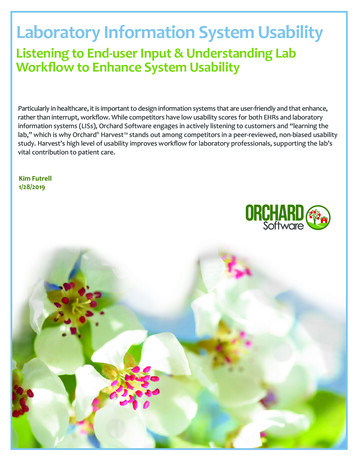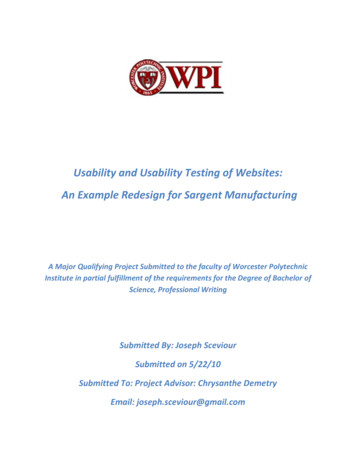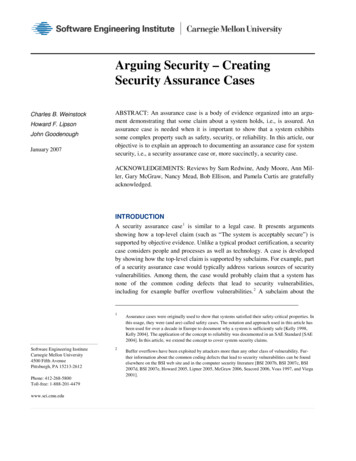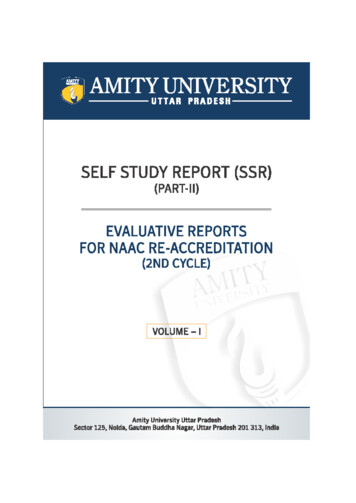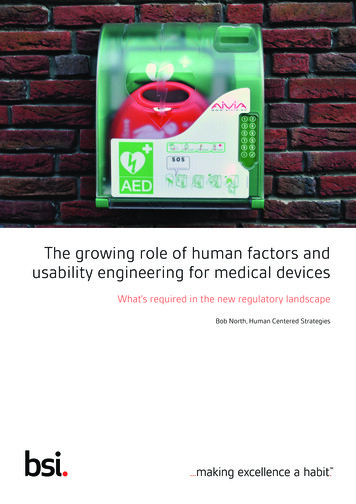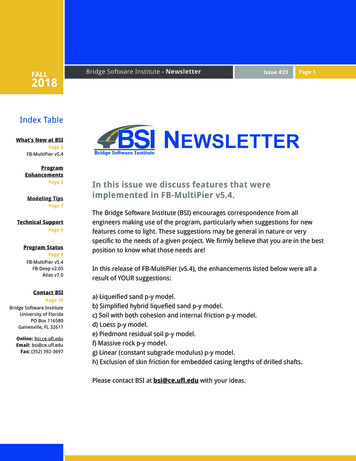
Transcription
Medical Device UsabilityDavid AdamsGlobal Head, Active Medical DevicesAdd logoon slide 4here
Topics What is usability? Why usability is so important The regulatory requirements EN 62366 Usability engineering process Notified Body Expectations2
Lifts in apartment and BSI office in China3
What is usability?4
Definition of Usability Characteristic of the USER INTERFACE that establishes EFFECTIVENESS,EFFICIENCY , ease of USER learning and USER satisfactionSource: Clause 3.17 of BS EN 62366:2008 A1:20155
Why usability is so important6
True StoriesDenise Melanson Four days of chemo drug in four hours; no antidote and died 22 dayslaterNurse’s suicide highlights twin tragedies of medical errors Kimberly Hiatt committed suicide after overdose killed baby.7
Why Usability is so important for Medical Devices? 98,000 recorded deaths annually in US caused by medical errors! A significant proportion of these involve devices Over a third of device incidents in US involve usability issuesSource: the pivotal 2000 report “To Err is Human,” by the Institute of Medicine8
Injuries associated with Infusion Pumps Between 2005 - 2009, FDA received approx. 56,000 reports ofadverse events with infusion pumps including numerous injuries and deaths. FDA Guidance on Infusion s/InfusionPumps/9
Different screens10
Hand-held pulse oximeter – Redesigned Display11
Why Usability is important? Reduce use error Improve performance in using devices Reduce training effort needed Usable products reduces the stress of the user12
Usability Involves a Shift of Mind-set Previously: “we design a device – its up to the user to use itaccording to our instructions” Now: “we design a device, accompanied by instructions and trainingcourses, which is easy to use correctly and guards against intentionalmisuse.”13
Regulatory Requirements14
EU & MDD - Ergonomic Design of DevicesAs design for patient safety initiatives play an increasing role in public health policy, it isnecessary to expressly set out the need to consider ergonomic design in theessential requirements.In addition the level of training and knowledge of the user, such as in the case of alay user, should be further emphasised within the essential requirements.The manufacturer should place particular emphasis on the consequences ofmisuse of the product and its adverse effects on the human body.Directive 2007/47/EC Recital 1815
MDD Annex I Essential Requirement ER 1 .any risks which may be associated with their intended use constitute acceptable riskswhen weighed against the benefits to the patient and are compatible with a high level of protection of health andsafety.This shall include:— reducing, as far as possible, the risk of use error due to the ergonomicfeatures of the device and the environment in which the device is intendedto be used (design for patient safety), and— consideration of the technical knowledge, experience, education andtraining and where applicable the medical and physical conditions ofintended users (design for lay, professional, disabled or other users).’16
MDD Annex I Essential Requirement ER 9.2 the risk of injury, in connection with their physical features, includingthe volume/pressure ratio, dimensional and where appropriate ergonomicfeatures ER 10.2 The measurement, monitoring and display scale must be designed inline with ergonomic principles, taking account of the intended purpose ofthe device. ER 13.1 Each device must be accompanied by the information needed to useit safely and properly, taking account of the training and knowledge of thepotential users, and to identify the manufacturer.” Other ERs that may be affected to some degree by ergonomics include 2, 3,6, 12.8, 12.917
Standards EN 60601-1:2005 3rd Ed A1:2013 – Medical electrical equipment –Safety & Essential Performance Cl 12.2 Manufacturer shall address risk of poor usability, includingmarking and documents, through a Usability Engineering process inaccordance with EN 60601-1-6.18
Standards EN 60601-1-6:2010Collateral Standard: Usability (IEC 60601-1-6:2010) – reference EN62366 EN 62366:2008 Medical devices - Application of usability engineering tomedical devices (IEC 62366:2007) EN 60601-1-8: 2007 - Alarm systems ISO 15223-1:2007 – Symbols 19
EN 62366Application of usability engineering to medical devices20
EN 62366:2008 Process based standard Objective: design in usability, design out errors Only 8 pages of requirements and 77 pages of guidance Process spans design and development life cycle21
EN 62366:2008 A User centred design process Usability Engineering Process Also applies to accompanying documents and user training Performs Risk Management – ISO 14971 Results of Usability Engineering Process shall be recorded in theUsability Engineering File Usability Engineering Process has 9 stages22
Usability Engineering Process1.2.3.4.5.6.7.8.9.Specify application of device –Intended use & UserIdentify frequently used functions - TaskIdentify hazards and hazardous situation related to usability – ISO 14971 –foreseeable misuseIdentify device primary operating functionsDevelop usability specificationPrepare usability validation planDesign and implement user interfaceUsability verification - verify user interfaceValidate usability of medical device23
NB Expectations of manufacturers24
Technical Audit Considerations Does ER1 address use error and intended users? Does manufacturer have a UE Process and a UEF? (Ideally theharmonised standard or rationale to meet ERs ) Where labelling and documentation are referenced in the RiskManagement process, has the usability of such documentation beenestablished? Has the effectiveness of training requirements and material beenestablished? Has suitability of Usability studies been justified?25
Technical Audit Considerations Sample from: Application Specification Determined frequently used functions Identified hazards and determined primary operating functions Usability specification Verified against usability specification Usability Validation Plan and Validation against plan NB would go into greater depth for design dossiers review26
Legacy Products Use Annex K of BS EN 62366:2008 A1 2015 as benchmark/guide Establish an application specification Identify and record Primary Operating Functions Review PMS Risk Assessment27
Regulatory expectation increasing Central Management Committee Statement on “Improvement ofReadability of Instructions for Use (IFU)” da -5-CMCStatement on Readability of IFU.pdf FDA’s expectations have also increased.28
MHRA Human Factors Project Group Purpose Raise profile of Clinical HF/Usability in UK and Europe Output – Human Factors Guidance Document Draft by April 2016 Publish July 2016? MHRA expect their NBs (and EU) to give sufficient importance to thistopic during assessments.29
Conclusion Usability is very important and has become a vital part of a medicaldevice Usability activities should be conducted throughout all phases of thedevelopment process, Usability should be part of the overall risk management process The regulators are increasing and enhancing the requirements forusability.30
Take home – BSI /resources/Whitepapers-and-articles/31
Questions?32
Appendix34
New Standards BS EN 62366:2008 A1 2015 5.10 User interface of unknown provenance Annex K – Evaluation of a user interface of unknown provenance IEC 62366-1:2015 Part 1: Application of usability engineering to medicaldevices IEC TR 62366-2:2016? Part 2: Guidance on the application of usabilityengineering to medical devices To be more “usable”, easier to understand than original 62366Contains the “what” requirements in Part 1, the “how” is in 62366-2Closer ties to risk management, EN ISO 14971Closer to FDA guidance35
New Standards New ISO 13485 Draft (DC2) 7.3.3 Design inputs include usability NOTE For information related to usability see ISO/IEC 6236636
US & FDA ANSI/AAMI HE48 (1988-2009) “Human factors engineeringguidelines and preferred practices for the design of medical devices” ANSI/AAMI HE74 (2001-2010) “Human factors design process formedical devices” ANSI/AAMI HE75 (2009- ) “Human factors engineering - Design ofmedical devices” (a Tutorial to HE-74)37
US & FDA FDA Human Factors Draft Guidance Document: Agency Expectations forHuman Factors Data in Premarket Submissions Applying Human Factors and Usability Engineering to Optimize MedicalDevice Design The FDA Perspective on Human Factors in Medical Device SoftwareDevelopment38
EN 60601-1:2005 3rd Ed A1:2013 - Medical electrical equipment - Safety & Essential Performance Cl 12.2 Manufacturer shall address risk of poor usability, including marking and documents, through a Usability Engineering process in accordance with EN 60601-1-6. 18 .
